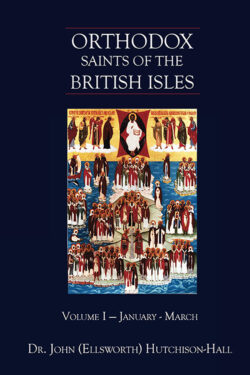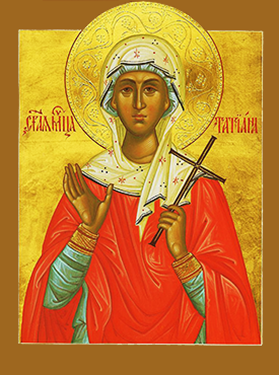
Orthodox Saints of the Pre-Schism
See of Rome
12th January 2024 (NS) — 30th December 2023 (OS)
ECGWINE (ECGWIN, EGWIN, EEGWINE) of EVESHAM, the details of St. Ecgwine’s life are rather incomplete, and he is not mentioned by either St. Bede the Venerable (25th May), nor in the Anglo-Saxon Chronicle. However, St. Ecgwine’s name is recorded in the witness lists of seven charters issued between 692 and 717, and named as beneficiary, on Evesham's behalf, of three others. He is generally considered to have been the third Bishop of Worcester (circa 693 – 717), and founder of Evesham Abbey (circa 700 – 710), in present-day Evesham, Worcestershire, England. It is known without question that his final episcopal act was his participation at the First Council of Clovesho (Clofesho) in July 716. As bishop, St. Ecgwine endeavoured to get his flock to embrace Christian morality, especially regarding marriage and clerical celibacy, however, he met with great resistance, and was at one point forced to appeal to Rome. St. Ecgwine is generally considered to have reposed on 30th December, 717, though at least one scholar claimed it was 720. He was buried at Evesham Abbey, and in 1183 his relics were translated to a shrine in the Abbey, which, unfortunately, was destroyed, along with the abbey church, during the Dissolution of the Monasteries in England and Wales (1536–1540) by Henry VIII, King of England and Ireland, (r. 1509–1547).
EUGENE, (Date Unknown), a Bishop of Milan, of whose life nothing is known.
LIBERIUS, an early Bishop of Ravenna in the Emilia-Romagna, who is considered to be one of the founders of that diocese. St. Liberius reposed circa 200.
SABINUS, EXUPERANTIUS, MARCELLUS, VENUSTIAN, and COMPANIONS, a group of Christians martyred in Spoleto during the Diocletianic Persecution (303–313). In some martyrologies they are called the Martyrs of Spoleto.
SEBASTIAN, consecrated Archbishop of Esztergom, Hungary in 1002. St. Sebastian worked with St. Stephen (16th August) in the evangelisation of the Hungarian people. St. Sebastian reposed circa 1036.
Get your copy of Orthodox Saints of the British Isles today.
Available at Amazon or your favourite e-bookstore.
ARCADIUS, a distinguished Christian member of society in Cæserea the capital of Mauritania Caesariensis (present-day Cherchell, Algeria) who went into hiding during a period of persecution. The authorities arrested a member of St. Arcadius’ family, threatening to torture him unless St. Arcadius surrendered. St. Arcadius presented himself to the authorities forthwith, and was told all would be released if he would simply make a public sacrifice to a pagan god. St. Arcadius rejected the offer and was slowly hacked to death, circa 302.
BENEDICT BISCOP, St. Benedict Biscop was a Northumbrian of noble birth, who spent his youth at the court of King Oswiu. Returning from his second pilgrimage to Rome, 666, he became a monk at Lérins. Three years later, he accompanied St. Theodore (19th September) to Canterbury, where he became Abbot of the monastery of SS. Peter and Paul (later St. Augustine’s). He went on to found the monasteries of St. Peter at Wearmouth (674) and St. Paul at Jarrow (682). St. Benedict was an ardent advocate of Roman liturgical practice, and was well known for his enthusiasm for art and learning, returning from each of his five trips to Rome with numerous paintings, relics, and manuscripts. He was responsible for bringing John the Archcantor of St. Peter’s in Rome to England to teach Roman chant, and is said to have introduced the use of glass windows and stone in the construction of English churches. St. Benedict’s Life was written by St. Bede the Venerable (25th May), who was St. Benedict’s charge from the age of seven.
CAESARIA, the sister of St. Cæsarius of Arles (27th August). Her brother appointed her Abbess of the Monastery of St. John which he had founded, and during her tenure the community grew to several hundred nuns. SS Gregory of Tours (17th November) and Venantius Fortunatus (14th December) described her as possessing outstanding gifts, St. Caesaria was renowned for her devotion to the poor, sick, and children. St. Caesaria reposed circa 530.
JOHN of RAVENNA, the Bishop of Ravenna in Emilia-Romagna from 452 until his repose in 494. St. John is remembered for protecting his flock from the savagery of Attila the Hun and secured better conditions for Ravenna after it had been occupied by Theodoric the Great, King of the Ostrogoths (r. 475–526).
PROBUS, a late sixth century Bishop of Verona of whom nothing further is known.
TATIANA and COMPANIONS, a renowned virgin-martyr from a prominent Roman family, and most likely a deaconess. St. Tatiana and others were martyred the persecutions during the reign of Emperor Severus Alexander, circa 226.
VICTORIAN of ASAN, a founder of monasteries and hospices in Italy. St. Victorian travelled west, spending time in France, and then to the Spanish Pyrenees where he founded and served as first abbot of a monastic community at Asan, now known as Monasterio de San Vitorián. St. Victorian reposed circa 560.
ZOTICUS, ROGATUS, MODESTUS, CASTULUS, and COMPANIONS, (Date Unknown), a group of forty to fifty soldiers martyred in North Africa. Nothing further is known of them.
Prior to the Schism the Patriarchate of Rome was Orthodox, and fully in communion with the Orthodox Church. As Saint John of Shanghai and San Francisco +1966 said “The West was Orthodox for a thousand years, and her venerable Liturgy is far older than any of her heresies”.
Details of British Saints excerpted from Orthodox Saints of the British Isles.
Details of continental saints from these sources.
In many cases there are several spelling versions of the names of saints from the British Isles. I use the Oxford Dictionary of National Biography version as the primary version with the more prevalent version in parenthesis e.g. Ceadda (Chad) of Lichfield.


